Improving Poultry Farming in Africa
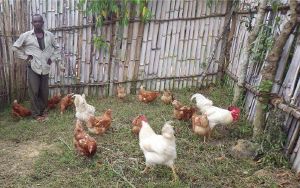
To improve food security of families in a village in Africa through a community project, enhancing the mastery of poultry farming.
Challenges
The objectives are to sustainably increase, diversify agricultural production and strengthen marketing channels for better environmental management of productive spaces.
| Problems | Solutions |
|---|---|
| Animals
wandering |
Semi-confinement |
| Local breed
low productivity |
Use of
other breeds |
| Significant
Mortality related to diseases |
New practices |
The practice of semi-confinement helps to prevent wandering and ensures a complete diet for animals. For optimal practices, adhering to a structured organization is crucial :
- Feed and water the subjects each morning in the poultry house.
- Let the subjects roam around the poultry house in the afternoon so they can supplement their diet themselves, but limiting the number of hours of exposure to potential predators.
- Bring all subjects back into the poultry house in the evening to prevent risks of predation, theft or losses.
- Monitor subjects every morning and every evening (number and physical condition).
Steps of implementing a community project
The community poultry house aims to produce chicks that are subsequently distributed to members to enhance their individual breeding workshops. The steps to carry out such a project are:
- Choosing a village with good social cohesion, willingness (having experience in poultry farming, agreeing to attend training sessions, committing to building their own poultry house) (at least 10 households), availability of land (with acquisition agreements) and construction materials.
- Organise an information meeting with villagers, with the agreement of the village chief. Presentation of the objectives of the poultry house, the terms of collaboration, the importance of unity and organization.
- Time for discussions and questions.
One to two weeks after the first meeting, with interested people :
- Election of a committee of 5 people (1 president, 1 vice president, 1 secretary, 1 treasurer, and 1 monitoring officer).
- Development of regulations to govern operations of the poultry house.
- A collaboration agreement is signed between the project and the farmers to determine the commitments of each party.
- Training, conducted in the community poultry house to be able to directly apply the knowledge learned. Use visual aids to facilitate the transmission and understanding of messages.
- The location of the community poultry house must be validated by the village chief and the villagers to avoid future disputes regarding the ownership of the building and enclosure. The project should encourage farmers to clearly define agreement clauses for provision of land and the future of the community poultry house.
Construction of a poultry house
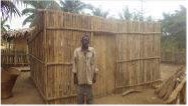
Objectives
- Create a favorable environment for poultry farming management: protection of subjects against theft, adverse weather conditions, predation, accidents, and diseases.
- Facilitate animal surveillance.
- Mastering production: health, nutrition, reproduction.
Organization tips
- Avoid periods of high mobilization of villagers in the fields for the start of work.
- Check the availability of construction materials.
- Provide advisory support at every stage of the construction to minimize errors leading to additional time and costs.
- Establish a deadline for the constructions to facilitate monitoring and prevent the work from taking too much time.
Prerequisites and necessary elements
The land
- Proximity to housing to facilitate access and monitoring.
- Should be well-ventilated and non-floodable.
- Close to trees to facilitate shade (fast-growing trees like Moringa or Spondias Lutea can be planted).
Materials
- For construction : Stakes, bamboo, palm leaves, Raphia vinifera, earth bricks, sticks, straw, wood, vines, thatch, live hedge plants, etc.
- For the poultry house:
- Feeders (to preserve food from contamination).
- Waterer (plastic or bamboo) to provide clean water, ensuring the installation of a device preventing the subjects from perching on the waterer.
- Nest box to ensure good laying conditions, positioned in a dark corner.
- Perch for comfort during rest periods.
The model
The poultry house should be oriented :
- East-West to limit the entry of the sun.
- According to the prevailing wind to reduce humidity and microbial activity.
Beforehand, it is necessary to ensure:
- Dimensions : They should correspond to the number of subjects to ensure favorable sanitary conditions inside the poultry house and to facilitate work. The general rule is usually 5 subjects per m2.
- Ventilation : Like any livestock building. Farmers should leave spaces for the circulation of air in the walls.
- Slope : On sloping land, it is necessary to plan to channel water to prevent runoff into the buildings.
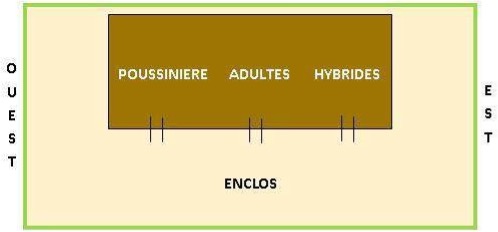
Bedding
The floor of the poultry house should be covered with a dry bedding of 10 cm thickness. It can be done with wood chips, dead leaves, or bagasse (fibrous residue from sugarcane).
This helps to avoid daily cleaning of the poultry house and produces a natural fertilizer for crops.
Poultry feeding
Feeding affects weight gain and egg laying (in quantity and quality). To ensure good nutrition, those in charge of the poultry house should be trained in the production of feed using local products (such as corn, soy, cowpea, and cassava) and the rules for distributing this feed.
Nutritional needs
Nutritional needs depend on age: an average of 1.5 kg per month from 0 to 18 weeks old, and beyond, 3.5 kg per month.
In villages, small farms typically have subjects at different growth stages, so an average of 3 kg per subject can be adopted.
The production of quality feed in sufficient quantity is the main constraint for farmers (difficult grinding, lack of raw materials, etc.). Semi-confinement thus allows subjects to supplement and diversify their daily ration without burdening the work of the farmers. Indeed, the local feed, made from corn, cowpea, and cassava, does not fully meet the nutritional needs of the subjects, complicating confinement farming. Therefore, semi-confinement has been proposed by the project as a farming method.
Preparation of feed
Preparing the ingredients
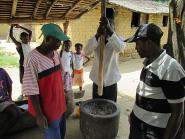
To make the feed, some utensils are necessary : a pot, a mortar, a pestle, a sieve, a scale, and a pan.
For soybeans or cowpeas (protein and lipid contribution):
- Beat soybeans or cowpeas to obtain seeds.
- Roast seeds (to deactivate anti-nutritional elements). Put seeds on the fire in a pot. Stir until the seeds become brittle and smell like biscuits (similar to roasted peanuts).
- Put seeds in the mortar and pound.
- Sieve and weigh.
For corn (carbohydrate contribution):
- Ensure that corn cobs are completely dry.
- Shell corn.
- Pound.
- Sieve and weigh.
For cassava (carbohydrate contribution):
- Wash cassava roots and cut them into small pieces.
- Let them dry for 4 to 5 days in the sun.
- Pound.
- Sieve and weigh.
Mixing process
Add palm oil to the mixture crumbs to reduce powdery texture. On a mixing area or a woven canvas bag, layer cassava, corn, and soybeans or cowpeas in batches of 5 layers each.
Packaging and storage
Place the mixture in woven canvas bags. Store in a dry place (elevated to prevent rat attacks).
Store for 2 months.
Feeding ration
A ration is the quantity of food distributed daily to a subject. It must contain all the elements necessary for growth and development of the animal:
- Carbohydrates found in cereals (corn, sorghum), roots, and tubers (cassava, sweet potatoes).
- Proteins found in legume seeds (soybeans, cowpeas, peanuts, pigeon peas) and in seeds and leaves of moringa.
- Lipids found in fats and oils (palm oil, oilseeds).
- Vitamins (necessary for physiological balance and the assimilation of other nutrients) found in edible green leaves (moringa) and in fruits (papayas, mangoes, etc.).
- Minerals (for skeleton and assimilation of food) found in lime powder, bone powder, shells, and fish waste.
Feed distribution
Distribution is usually done in the morning and in sufficient quantity according to the growth stage:
- Distribute 15 grams per subject per day from the first week.
- Increase the quantity by 5 grams/day each week until the 22nd weeks old, then stabilize the intake at 120 g/subject/day until culling.
- Distribute feed in feeders (bamboo or metal) to prevent waste or contamination.
- Ensure permanent availability of good-quality water.
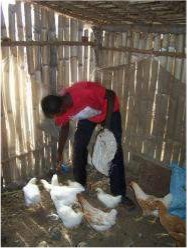
Feed changes
The transition from one feed to another must be done gradually to avoid stressing animals.
It will be done gradually over 7 days according to the rhythm and the ratio: % old feed / % new feed as follows:
- Day 1 - Day 2: 75% / 25%.
- Day 3 - Day 4: 50% / 50%.
- Day 5 - Day 6: 25% / 75%.
- Day 7: 0% / 100%.
Hygiene and animal health
In the management of small poultry farms, good animal health plays a crucial role. The transition from free-ranging to semi-confinement requires training farmers in the basic rules of preventing health risks and their treatment.
Objectives include:
- Maintain good health of the subjects.
- Limit risks of parasitic and diarrheal diseases.
- Minimize losses of subjects and economic losses related to diseases (growth delay, egg drop, low hatch rate, poor meat quality).
- Implement sanitary and medical prophylaxis measures while respecting farming methods.
Main health rules
Flock size per poultry house
Recommended density: 5 subjects / m² / breeding hens.
Cleaning
- Daily cleaning of waterers and feeders.
- Replacement of bedding every 2 or 3 months.
- Replace bedding if it is damp (risk of coccidiosis).
Feeding
- Water renewed daily.
- Device on the drinkers preventing subjects from perching on them.
- Daily feeding according to the subjects growth.
Disease control
Diseases can be prevented through preventive practices or cured through curative practices.
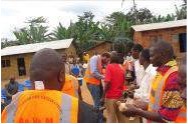
Virulent Newcastle disease / Avian disease
Symptoms
- Difficulty breathing.
- Paralysis.
- Tremors.
- Diarrhea.
- Reduced egg production or abnormal eggs.
Measures
- Preventive: Oral or ocular-nasal vaccination (I-2 thermotolerant vaccine for subjects of all ages). If losses due to Avian Pseudo Plague (APP) are recurrent and decimate the flocks, preventive vaccination should be considered. The treatment is financially accessible (approximately 6 dollars for 200 doses).
Vaccination procedure
- For ocular-nasal administration, find a dropper and calculate the amount of diluent needed for 200 drops (which represent 200 doses for 200 subjects).
- The product "shaldex" (treatment) is anti-inflammatory for the eyes. Dilute the vaccine in 1 vial of 10 cc (use single-use droppers).
Gumboro disease
Symptoms
- Loss of appetite.
- Weight loss.
- Paralysis.
- Tremors.
- Lethargy.
Measures
- Preventive: Oral vaccination (dilute the vial in 1 to 5 liters of water). Doses: 1st week old, booster before the onset of laying, at the 18th week of age.
- Curative: Sugar: 2g/L of water for 4 days. Diaziprim (soluble powder to prevent bacterial complications).
Fowlpox
Symptoms
- Conjunctivitis.
- Sneezing.
- Difficulty swallowing and breathing.
- Crusts on the comb and wattles.
Measures
- Preventive: Vaccine in a vial (1000 doses with diluent and vaccines). 1st dose at 2 weeks old. Booster before the onset of laying. Dose at the 18 weeks old.
- Curative: Phenol solution: 0.5 to 1 cc/subject, subcutaneously, at the neck level. Repeat after 8 days.
Histomoniasis (Histomonas gallinarum)
Symptoms
- Brownish diarrhea.
Measure
- Curative: Diaziprim for 5 days (250g in 1.5 liters of water).
Worm infestation (Ascaridiasis and Capillariasis spp)
Symptoms
- Lack of appetite.
- Diarrhea.
- Growth slowdown.
- Reduced egg production or malformed eggs.
Measures
- Preventive: Levamisole: 0.5 g/liter of water for the 1st day. Repeat after 45 to 60 days.
- Curative: Preventive measure + vitamins: 0.5g to 1g/liter of water for 3 days.
Nutritional deficiency diseases (Deficiency in vitamin D, Calcium, Phosphorus, Vitamins)
Symptoms
- Leg deviation.
- Feather loss.
- Growth retardation.
Measures
- Preventive: Balanced diet.
- Curative: Mineral supplement, vitamin in case of deficiency: 2g salt/liter of water for 2 days.
Coccidiosis (Eimeria avium Coccidiosis)
Symptoms
- Red diarrhea.
- Drop in egg production.
- Lack of appetite.
- Weight loss.
Measures
- Preventive: Coccidiostat in the diet.
- Curative: Emprolium: 1g/liter for 3 days.
Required materials
- Vaccines and droppers.
- Diluent or spring water.
- Ice tray and ice packs.
Maintaining the cold chain is essential to ensure the success of vaccination. Vaccines must be kept refrigerated.
Sources
This page was written in partnership with the Urbane project and with the financial support of the European Union.




